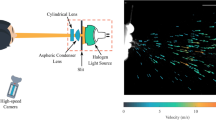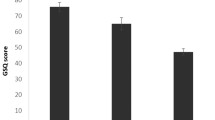Abstract
Objective
The purpose of this study is to explore how performing qigong influences certain measurable aspects of the human biofield; namely, various calculated parameters of finger corona discharge patterns produced by high-voltage electrophotography.
Methods
The Gas Discharge Visualization (GDV) camera was used to assess subjects before and after performing Dayan (wild goose) qigong in workshop settings. Sixteen adults (48–80 years old), seven diagnosed with chronic disease, were studied. Subjects ranged from qigong novices to those having had 8 years of practice. Measurements were made on all ten fingertips of 16 subjects pre- and post-qigong. The patterns of light emitted from the subjects’ fingertips were digitally recorded and computer analysed. Parameters including normalised area, brightness, density, fractality form coefficient, fractality dimension, and right- and left-hand integrals were calculated and statistically compared.
Results
The uniformity of the density of the circles of light emitted from the fingertips increased post-qigong. A trend was observed for the variability in the fractal form coefficient to decrease post-qigong. Subjects with chronic health problems increased in fractal dimension post-qigong, while those without health problems showed a decrease. There was a trend for the light emitted by the fingertips of qigong-experienced subjects to decrease in brightness, whereas inexperienced subjects had increased brightness. The right integral increased post-qigong in experienced subjects, whereas the left integral increased in inexperienced subjects.
Conclusions
Qigong practice influenced some of the GDV parameters of the finger emission patterns significantly but the data supported only some of our hypotheses. The GDV technique may be a valuable tool in assessing changes in parameters of the human biofield both clinically and in investigating mechanisms of action of complementary and alternative medicine interventions.







Similar content being viewed by others
References
Sancier KM. Medical applications of qigong. Altern Ther Health Med 1996; 2(1): 40–6
Wang C, Xu D, Qian Y. Medical and healthcare qigong. J Tradit Chin Med 1991; 11(4): 296–301
Sancier KM. Therapeutic benefits of qigong exercises in combination with drugs. J Altern Complement Med 1999; 5(4): 383–9
Reuther I, Aldridge D. Qigong Yangsheng as a complementary therapy in the management of asthma: a single-case appraisal. J Altern Complement Med 1998; 4(2): 173–83
Chen KW, Shiflett SC, Ponzio NM, et al. A preliminary study of the effect of external qigong on lymphoma growth in mice. J Altern Complement Med 2002; 8(5): 615–21
Iawo M, Kajiyama S, Mori H, et al. Effects of qigong walking on diabetic patients: a pilot study. J Altern Complement Med 1999; 5(4): 353–8
Wu WH, Bandilla E, Ciccone DS, et al. Effects of qigong on late-stage complex regional pain syndrome. Altern Ther Health Med 1999; 5(1): 45–54
Li M, Chen K, Mo Z. Use of qigong therapy in the detoxification of heroin addicts. Altern Ther Health Med 2002; 8(1): 56–9
Kuang, Wang C, Xu D, et al. Research on the anti-aging effects of qigong. J Tradit Chin Med 1991; 11(2): 153–8
Tsang HWH, Mok CK, Au Yeung YT, et al. The effect of qigong on general and psychosocial health of elderly with chronic physical illnesses: a randomized clinical trial. Int J Geriatr Psychiatry 2003; 18: 441–9
Sancier KM. Electrodermal measurements for monitoring the effects of a qigong workshop. J Altern Complement Med 2003; 9(2): 235–41
Sancier KM. The effect of qigong on therapeutic balancing measured by electroacupuncture according to Voll (EAV): a preliminary study. Acupunct Electrother Res 1994; 19(2/3): 119–27
Wirth DP, Cram JR, Chang RJ. Multisite electromyographic analysis of therapeutic touch and qigong therapy. J Altern Complement Med 1997; 3(2): 109–18
Ryu H, Lee HS, Shin YS, et al. Acute effect of qigong training on stress hormonal levels in man. Am J Chin Med 1996; 24(2): 193–8
Litscher G, Wenzel G, Niederwieser G, et al. Effects of qigong on brain function. Neurol Res 2001; 23(5): 501–5
Zhang H-C. Wild goose Qigong: natural movement for healthy living. Boston (MA): YMAA Publication Center, 2000: 19–102
Rubik B. The biofield hypothesis: its biophysical basis and role in medicine. J Altern Complement Med 2002; 8(6): 703–17
Kirlian S, Kirlian V. Photographing and visual observation by means of high frequency currents [in Russian]. J Sci Appl Photography 1961; 6(6): 397–403
Mandel P. Energy dmission analysis: new application of Kirlian photography for holistic medicine. West Germany: Synthesis Publishing Co., 1986
Korotkov K. Aura and consciousness. St Petersburg: Russian Ministry of Culture, State Editing and Publishing Unit, 1999: 84–108
Russo M, Choudhri AF, Whitworth G, et al. Quantitative analysis of reproducible changes in high-voltage electrophotography. J Altern Complement Med 2001; 7(6): 617–29
Bevk M, Kononenko K, Zrimek T. Relation between energetic diagnoses and GDV images. Proceedings of the New Science of Consciousness Conference; 2000 Oct; Ljublana, Russia, 54–8
Dobson P, O’Keffe E. Investigations into stress and its management using the gas discharge visualization technique. Intern J Altern Complement Med 2000; 3: 12–7
Rubik B. Scientific analysis of the human aura. In: Heinze RI, editor. Proceedings of the 18th International Conference on the Study of Shamanism and Alternative Modes of Healing, Santa Sabina Center, Dominican University, San Raphael, CA, September 1–3, 2002. Berkeley (CA): Independent Scholars of Asia, Inc., 2002: 235–57
Bell I, Lewis DA, Brooks AJ, et al. Gas discharge visualization evaluation of ultramolecular doses of homeopathic medicines under blinded, controlled conditions. J Altern Complement Med 2003; 9(1): 25–38
Korotkov KG. Human energy field: study with GDV bioelectrography. Fair Lawn (NJ): Backbone Publishing Co., 2002: 274–5
Korotkov KG. Human energy field: study with GDV bioelectrography. Fair Lawn (NJ): Backbone Publishing Co., 2002: 112–3
Korotkov KG. Human energy field: study with GDV bioelectrography. Fair Lawn (NJ): Backbone Publishing Co., 2002: 301–5
Korotkov KG. Human energy field: study with GDV bioelectrography. Fair Lawn (NJ): Backbone Publishing Co., 2002: 73–8
Acknowledgements
This study was supported in part by NIH grant P20 AT00774 from the National Center for Complementary and Alternative Medicine (NCCAM) and a grant from the Lifebridge Foundation. The contents of this paper are solely the responsibility of the authors. The authors have no conflicts of interest that are directly relevant to the contents of this study.
The authors thank Bett Lujan Martinez for her helpful input; Bett Lujan Martinez and Effie Chow, PhD for the opportunity to conduct the study; and Brian R. Faust for his assistance with the manuscript.
Author information
Authors and Affiliations
Corresponding author
Rights and permissions
About this article
Cite this article
Rubik, B., Brooks, A.J. Digital High-Voltage Electrophotographic Measures of the Fingertips of Subjects Pre- and Post-Qigong. Evid-Based-Integrative-Med 2, 245–252 (2005). https://doi.org/10.2165/01197065-200502040-00007
Published:
Issue Date:
DOI: https://doi.org/10.2165/01197065-200502040-00007




